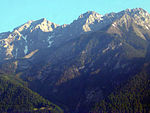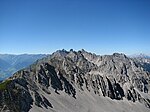Hintere Brandjochspitze
AC with 0 elementsInnsbruckKarwendelMountains of Tyrol (state)Mountains of the Alps ... and 1 more
Two-thousanders of Austria

The Hintere Brandjochspitze (2,599 m (AA)) is a summit roughly 200 metres northwest of the Vordere Brandjochspitze in the Nordkette range above Innsbruck. It rises above its "forward" neighbour by around 40 metres. The summit may be reached in 20 minutes from the Vordere Brandjochspitze at climbing grade UIAA I through a gully left of the arête. A more difficult route runs along the western arête (grade III-) from the Hohe Warte. Other routes along the northern Hippengrat (UIAA IV) from the Hippenspitze (2,388 m) and from the northwest (UIAA IV) are rarely used.
Excerpt from the Wikipedia article Hintere Brandjochspitze (License: CC BY-SA 3.0, Authors, Images).Hintere Brandjochspitze
Südgrat Vordere Brandjochspitze, Innsbruck
Geographical coordinates (GPS) Address Nearby Places Show on map
Geographical coordinates (GPS)
| Latitude | Longitude |
|---|---|
| N 47.30306 ° | E 11.33917 ° |
Address
Südgrat Vordere Brandjochspitze
Südgrat Vordere Brandjochspitze
6020 Innsbruck (Hötting)
Tyrol, Austria
Open on Google Maps










